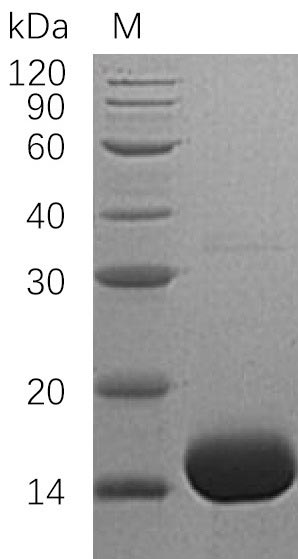Recombinant Human Interleukin-3 (IL3) is produced in E. coli and represents the full length of the mature protein, spanning amino acids 20-152. It features an N-terminal 6xHis-tag for easier purification. The product achieves high purity of over 95% as verified by SDS-PAGE and maintains an endotoxin level of less than 1.0 EU/µg, making it suitable for research applications. The protein shows biological activity and can bind Human IL-3RA-Fc with affinity constants of 3.89 µM and 3.74 µM in BLI assays.
Interleukin-3 (IL3) is a cytokine that appears to play a significant role in hematopoiesis, particularly in the differentiation and proliferation of hematopoietic stem cells. It participates in signaling pathways that may regulate immune cell development and function. IL3's activity seems critical for maintaining the balance of various blood cell types, which is why it has garnered considerable interest in research focused on immunology and hematological studies.
Potential Applications
Note: The applications listed below are based on what we know about this protein's biological functions, published research, and experience from experts in the field. However, we haven't fully tested all of these applications ourselves yet. We'd recommend running some preliminary tests first to make sure they work for your specific research goals.
1. IL-3 Receptor Binding Studies and Affinity Characterization
This recombinant IL-3 is confirmed to bind IL-3RA with consistent affinity (3.74-3.89 μM) in BLI assays, making it suitable for receptor interaction studies. However, the micromolar-range affinity is relatively weak compared to high-affinity cytokine-receptor interactions (typically nanomolar), suggesting this may represent a low-affinity binding state or the His-tag/N-terminal may be affecting the binding interface. Researchers should validate binding with primary cells expressing the complete IL-3 receptor complex (αβc heterodimer) to confirm physiological relevance.
2. Hematopoietic Cell Culture and Proliferation Assays
While IL-3 is a hematopoietic growth factor, the demonstrated activity is limited to receptor binding without cell-based functional validation. The micromolar binding affinity suggests this protein may have reduced potency in cellular assays compared to native IL-3 (which typically acts in the low nanomolar range). Researchers should first establish functional ED₅₀ in relevant hematopoietic cell lines (e.g., TF-1, MO7e) before proceeding to primary cell cultures.
3. Antibody Development and Immunoassay Standardization
The high-purity IL-3 serves as a good antigen, but the E. coli expression produces a non-glycosylated protein, and antibodies may not recognize glycosylated epitopes present in native IL-3. The His-tag may also induce tag-specific responses. Comprehensive validation should include testing against mammalian-expressed, glycosylated IL-3 to ensure recognition of physiological forms.
4. Protein-Protein Interaction Studies
The protein can be used for interaction studies, but the weak binding affinity may challenge the detection of weaker interactions. The His-tag facilitates pull-down assays but may increase non-specific binding. Identified interactors should be validated with functional cellular assays to confirm biological relevance, particularly given the relatively low receptor binding affinity.
5. Structure-Function Relationship Analysis
The protein is suitable for mutagenesis studies, but the micromolar-range binding affinity suggests the protein may not be optimally folded or may lack important post-translational modifications. Mutagenesis studies should include mammalian-expressed IL-3 as a reference to distinguish mutation effects from the inherent low affinity of the E. coli-expressed protein.
Final Recommendation & Action Plan
This E. coli-expressed human IL-3 with N-terminal His-tag demonstrates consistent but relatively weak receptor binding affinity (∼3.8 μM), which is concerning as native IL-3 typically exhibits nanomolar affinity. Before extensive use, researchers should: 1) Validate functional activity in cell proliferation assays using IL-3-responsive cells (e.g., TF-1) to determine if the weak binding translates to reduced potency; 2) Consider testing a mammalian-expressed version to compare binding affinity and functional potency; 3) For antibody development, use this protein for initial immunization but screen against mammalian-expressed IL-3 to ensure recognition of properly folded, glycosylated protein; 4) For interaction studies, the weak affinity may limit detection of transient interactions, so use sensitive methods and include appropriate controls; 5) The His-tag at the N-terminus is less likely to interfere with receptor binding than a C-terminal tag, but may still affect the N-terminal region which is important for IL-3 function. Proceed with caution for functional studies until cellular activity is confirmed, and prioritize validation of key findings with mammalian-expressed IL-3 when possible.






